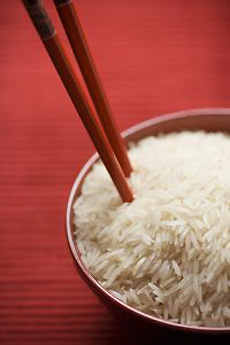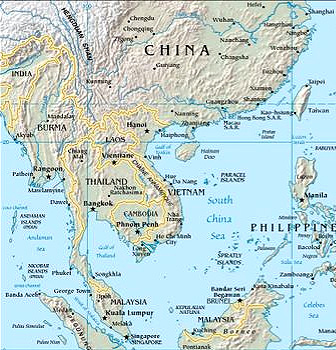

Basmati rice, a long-grain cultivar from India known for its fragrance and subtle flavor, has been discovered in recent years by American chefs. Photo by Brandon W. Mosley | SXC.
October 2007
Last updated February 2010
|
 |
Rice: History & Types Of Rice
Page 1b: Rice History
CAPSULE REPORT: Learn all about rice, how it is cultivated and the many different types of rice in this comprehensive review. Click on the black links below to visit other pages of the article.
The History Of Rice
Americans are not big rice eaters: Statistics say that we eat just 25 pounds per year, with about four pounds of that attributed to brewing beer. In Myanmar (the former Burma), a person eats 500 pounds of rice a year, or 1¼ pounds per day. But then, rice cultivation may have originated in one of the long valleys of Myanmar’s Shan Upland, or nearby. Radiocarbon dating of strata containing grains of rice found in south China indicate rice was cultivated as far back as 7,000 year ago. Researchers believe rice may have been indigenous to what is now India; domestication (cultivation) most likely took place in the Assam area of northeast India, southwestern China, Myanmar or Thailand. You can see from the map below that these countries are neighbors in southeast Asia.
|
Wild rice (the rice plant growing wild, as opposed to the grass known today as wild rice) was cultivated perhaps by 4000 B.C.E. Pottery shards carbon-dated to then, bearing the imprint of both the grains and the husks of rice (Oryza sativa), were discovered at Non Nok Tha in the Korat area of Thailand.* Rice then moved to the rest of Indochina (the peninsula of Thailand and Cambodia) and southeast Asia. The first written record of rice cultivation dates to China around 2800 B.C.E., in a decree on rice planting authorized by a Chinese emperor.
|

Map of southeast Asia from the World Fact book, essayservice The area called Burma is now known as Myanmar. |
Rice reached western India about 2500 B.C.E. and Sri Lanka, an island off the coast of India, around 1000 B.C.E. It took a while longer to get to the West.
*From Guide To Thailand.
Rice first came to Europe—to Greece—when members of Alexander the Great’s expedition to India, 344 to 324 B.C.E., returned with it. By the time of the Roman Empire, some rice was grown around the Mediterranean Sea, in southern Europe and North Africa, including Egypt.
In the Late Middle Ages in Europe, people blamed rice and the standing water in rice paddies for causing malaria, by giving the mosquitoes a good place to lay their eggs. Many towns discouraged farmers from planting rice to try to prevent malaria. (However, extensive knowledge and use of rice in Europe date back only to the fifteenth century.)
Continue To Page 1c: Rice In America
Go To The Article Index Above

|





